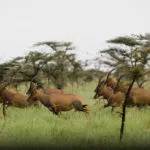
(NEW YORK) — South Sudan is trying to protect the largest land mammal migration in history by partnering with the nonprofit organization African Parks to safeguard the migratory species that rely on the ecosystem to survive.
The migration has enabled animals such as the white-eared kob, tiang, Mongalla gazelle and bohor reedbuck — all types of antelope — to survive seasonal changes for decades. The partnership aims to protect up to six million animals on the east bank of the White Nile, a tributary of the Nile.
Despite several challenges in the country — including destructive fooding, famine and a recent Civil War — many animals have survived by sticking to ancient migration routes. The animals travel through a so-called “No Man’s Land,” which are vacant areas bordering the various tribes that indigenous people leave free for the animals to journey through.
In 2022, African Parks and the government of the Republic of South Sudan signed a 10-year agreement for the management of Boma National Park and Bandingilo National Park, which both fall in “No Man’s Land” to help protect the species.
Researchers have long known the migration existed, but didn’t understand exactly how it worked. To learn the animals’ migration patterns, African Parks with South Sudanese students at Juba University and people from ethnic groups conducted aerial surveys over six months in 2023. The aerial surveys collected eight hours of daily data, counting every animal and identifying each species.
After observing their patterns, African Parks noticed that the animals moved in a circular route influenced by rainfall, meaning the animals were trying to find water resources during their migration — typical for them during migration.
“We flew for the first 30 to 40 minutes, and we didn’t see anything. I was like, ‘Oh, no, maybe it’s over. Maybe the wildlife has already disappeared,’” David Simpson, park manager for African Parks, told ABC News, sharing his insights from being aboard an aircraft for one of the surveys. “Then we get out there and we start hitting one, two, three, four. Then we start hitting hundreds and then we start hitting thousands, and then tens of thousands, then hundreds of thousands.”
African Parks began collaring species involved in the migration, as well as giraffes, lions, Nile lechwe, elephants and cheetahs, to track their movements and understand the factors driving them.
Last year, African Parks rangers collared 126 animals across different species, and this year they collared 127 animals, with plans to increase the number each subsequent year.
There are seventeen ethnic groups in South Sudan, each depending on the animals for clothing, shelter materials, medicine and to uphold their cultural traditions. The groups said they believe the migration is a sacred symbol of abundance and prosperity, believing it reflects the relationship with nature that they’ve known from generation to generation.
The communities are also collaborating with African Parks to learn how to implement conservation measures that reduce threats to wildlife and help preserve various species.
“Most of the people view the migration as something that has been going on for centuries,” Anthony Abang John Urbano, a member of the Bahr el Ghazal tribe, told ABC News.
Urbano has worked as a backseat observer during African Parks’ aerial surveys and continues to work as control operator with the organization.
“When it comes to some specific communities, [the migration is] a mystery, but they all are benefiting from the same migration — it’s a mutual benefit,” he said.
In an effort to bridge the gaps between conservation and indigenous survival, African Parks has brought on numerous indigenous members to be part of its team. Together they say they are working with ethnic communities to raise awareness about animal conservation, preserving the ecosystem and fostering community involvement.
“They are really proud that we are exposing that natural resource, especially the wildlife under conservation of South Sudan,” Juanna Kenneth Ali, a member of the Moru tribe and technician for African Parks, told ABC News. “They are really proud that I am part of a group who did great work exposing our nature to the world”.
It comes as South Sudan faces increasing human development including the creation of roads and the commercialization of bushmeat poaching, which poses a threat to the sustainability of wildlife and ethnic communities.
African Parks predicts that if the partnership with the South Sudanese government doesn’t continue and indigenous groups are not educated about conservation, the animals could vanish within five to 10 years. However, conservation must be balanced with tourism, which is needed to help boost the economy., the group says.
“When it comes to understanding the wildlife and interacting communities, human development can only lead to a sign of an animal losing its natural behaviors and, some suggest losing agility,” noted Mapour Kuot Mungu, a control operator of African Parks’ South Sudan team and a member of the Bahr el Ghazal tribe, told ABC News. “With time, these animals become vulnerable to practices being caused by humans.”
Copyright © 2024, ABC Audio. All rights reserved.
